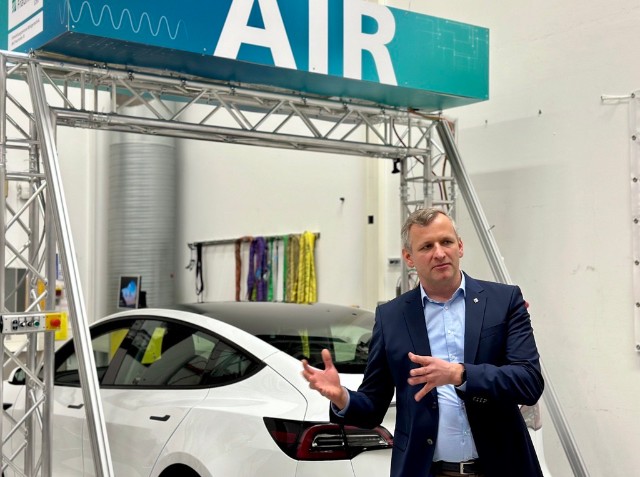Safe on the road: "AIR" X-ray system examines electric car batteries
The Fraunhofer Development Centre for X-ray Technology, a division of the Fraunhofer Institute for Integrated Circuits IIS, has presented a new type of testing facility for electric vehicle batteries.
In collaboration with Munich University of Applied Sciences, the scientists presented the "AIR" research project (traction battery inspection using X-rays), presented measurement results from preliminary studies and categorised the opportunities that could open up for private users once the research project has been completed.
The complete X-ray inspection of fully assembled vehicles can currently only be carried out under laboratory conditions at a few locations worldwide - including the X-ray Technology Development Centre at Fraunhofer IIS in Fürth. However, the procedure is complex and costly, meaning that its use is currently reserved for companies that inspect safety-relevant components in particular during the development process. The newly developed AIR system (traction battery inspection using X-rays) changes this: the system makes it possible to visually assess the mechanical integrity of battery modules by taking an X-ray image of the vehicle and the traction battery mounted in the underbody. To do this, the vehicle is driven into the measurement system - the measurement setup is reminiscent of a classic car wash. The X-ray images are taken from a bird's eye view. The X-ray source positioned above the vehicle emits a fine X-ray beam that passes through the vehicle, including the battery, and is picked up and processed by a detector positioned on the ground. Even in fully encapsulated battery modules, a detailed view of the battery is possible in order to make statements about the mechanical condition of individual battery cells, the battery frame and other features. The new system is specially designed to meet the requirements of the fastest and most cost-effective testing possible.
The market needs objective valuation options
Up to now, a well-founded assessment and evaluation of the condition of an electric vehicle battery has only been possible in a very rudimentary way. Experts such as Prof Klaus Böhm from Munich University of Applied Sciences have to rely largely on diagnostic tools provided by the manufacturers. "In practice, the process is essentially the same as we know it from the fault diagnosis of reasonably modern vehicles. Plug it in and diagnostic software reads out any problems. In some cases, this is carried out over several days while driving. In the case of more serious accidents, for example if the airbag in the vehicle has been triggered, there are very clear instructions from the manufacturer. In such cases, it is usually mandatory to replace the traction battery, even if it may not have been damaged," says Prof Böhm. On the one hand, such strict safety precautions are currently unavoidable in order to ensure the operational safety of vehicles - and therefore also the safety of passengers and other road users. On the other hand, it is questionable from the point of view of sustainability and resource conservation to recycle harmless, functional batteries. "There is a great need in the market for an additional objective assessment option for vehicle batteries. This is why we have been researching X-ray systems for many years, which could play a central role in the assessment of high-performance batteries," says Michael Salamon, Group Manager at the X-ray Technology Development Centre at Fraunhofer IIS.
Call for study participation
In future, the system will be tested and further developed in the field for damage assessment, valuation and life cycle analysis applications. In order to accelerate the development and rapid automation of the new technology, Fraunhofer IIS is currently looking for test subjects who will make their vehicle available for the collection of X-ray data. If you are interested in taking part in the study, we look forward to hearing from you at info-ezrt@iis.fraunhofer.de.
Comments on the project
Michael Salamon, Fraunhofer IIS: "For the first time, AIR technology opens up the possibility of analysing the vehicle underbody in detail quickly and easily. By focussing the technology on the life cycle of vehicles, Fraunhofer IIS is doing pioneering work as part of a strategic initiative to increase confidence in the still young technology and thus promote the emerging used car market, among other things."
Prof. Klaus Böhm, Munich University of Applied Sciences: "AIR has the potential to revolutionise the preparation of expert reports in the context of electromobility - and beyond. The described limitations of the methods used to date can be significantly expanded by incorporating AIR into a multidisciplinary approach. This will contribute to a reduction in repair costs for electric vehicles. More accurate and reliable appraisals can also lead to more predictable used car processes and more favourable insurance premiums for electric vehicles."
News about battery research at Fraunhofer IIS can be found in the series: https://www.iis.fraunhofer.de/de/magazin/serien/serie-batterieforschung.html

© Fraunhofer IIS/Christina Müller | Michael Salamon, Group Manager for High Energy X-ray Systems, presents the new testing option for electric vehicle batteries.

© Fraunhofer IIS | Complete scan of the battery modules of an electric vehicle with the AIR portal. The individual cylindrical battery cells and their correct position are clearly visible, ruling out the possibility of damage.

© Fraunhofer IIS/Christina Müller | The measurement setup of the AIR X-ray system is reminiscent of a classic car wash: the X-ray source positioned above the vehicle emits a fine X-ray beam that passes through the vehicle, including the battery, and is collected and processed by a detector positioned on the ground.

© Fraunhofer IIS/Paul Pulkert | The "AIR" X-ray system examines electric car batteries.



